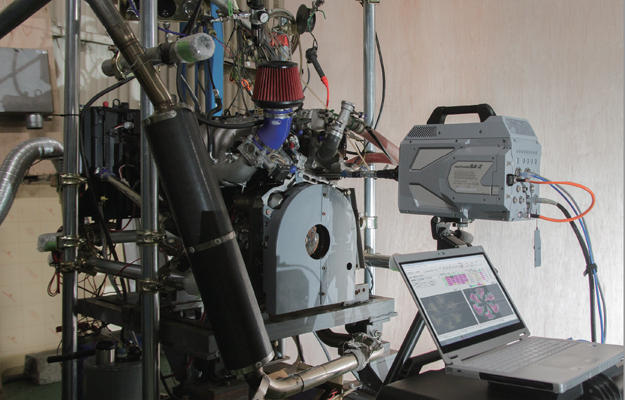Combustion

COMBUSTION
Combustion research involves the complex study of a chemical reaction between multiple substances. The speed at which the substances combine is very high due to the energy that is generated by the combination of oxygen and heat or flame. The study of combustion is based on the knowledge of chemistry, physics, and mechanics. Combustion research is utilized in a wide range of applications, including engine testing in the automotive industry and in rocket and jet engine testing in the aerospace industry.
Pulse train ignition with passively Q-switched laser spark plugs
Leaner burning and downsizing are two concepts pursued by engine developers to reduce fuel consumption and emissions. Both approaches lead to increasing challenges concerning ignition, as these concepts are typically associated with an increase in flow velocity and degree of turbulence as well as raised pressure at the moment of ignition. In this context, the use of miniaturized passively Q-switched laser spark plugs with pulse train ignition is considered as a promising alternative to conventional spark plugs.
Experimental study of stratified lean premixed methane/air low-swirl turbulent flame
Simultaneous high-repetition rate (3 kHz) CH2O planar laser-induced fluorescence (PLIF) and particle image velocimetry (PIV) measurements were performed in in turbulent low swirl stratified premixed methane/air flames to investigate the large-scale spatial and temporal evolution of the flame and flow dynamics. In addition, PLIF of OH and CH2O at a low-repetition rate (10Hz) were carried to study the global effect of equivalence ratio, ϕ, on the flame. A low swirler burner was used to stabilize a wide range of flames, from close-to-quenching lean flames to close to stoichiometric flame with ϕ = 0.9. The flames exhibit a laminar flamelet structure in the leading front and thickened flame structure with local quenching at the trailing edge. Detailed statistical data are obtained, including the velocity field, the mean flame location; preheat layer thickness, flame brush thickness and the flame surface density. These data provide a useful database for comparison of combustion model simulations. The results reveal interesting flame behaviour; depending on the equivalence ratio the large scale interaction between the flame and the flow field takes different forms.
Simulating Bluff-body Flameholders: On the Use of Proper Orthogonal Decomposition for Combustion Dynamics Validation
Contemporary tools for experimentation and computational modeling of unsteady reacting flow open new opportunities for engineering insight into dynamic phenomena. In the work presented here, a novel use of proper orthogonal decomposition (POD) is described to validate the structure of dominant heat release and flow features in the flame, shear-layer, and wake of a bluff-body-stabilized flame. A general validation process is presented which involves a comparison of experimental and computational results, beginning with single-point mean statistics and then extending to the dynamic modes of the data using POD to reduce the ensemble of instantaneous flow field snapshots. The results demonstrate the use of this technique by applying it to large eddy simulations of the bluff body stabilized premixed combustion experiment.
